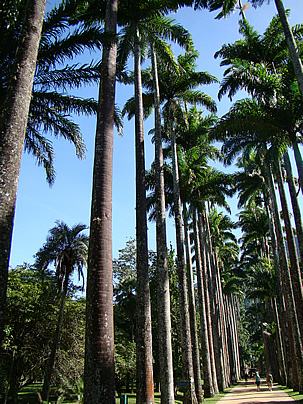The Caribbean Royal Palm (Roystonea oleracea) is a species of monocious, solitary, and imposing palm, very robust and large, reaching between 30 and 40 meters (98 to 131 feet) in height. The leaves are 3 to 5 meters (9.8 to 16.4 feet) long, pinnate, with arched leaflets inserted in the same plane, thus differing from the Cuban Royal Palm (Roystonea regia), which has more feathery leaves. Its stem (trunk) is light gray, smooth, uniformly cylindrical, slightly thickened at the base, with a diameter between 40 and 60 centimeters (15.7 to 23.6 inches).
The crown is rounded, with approximately twenty leaves arranged upright or horizontally, allowing the crownshaft covered by the sheaths to be visible from a distance, another feature that sets it apart from the Cuban royal palm. In the latter, older leaves hang over the crownshaft, making it difficult to see.
The inflorescence appears at the base of the crownshaft in the spring, in long clusters, up to 1.5 meters (4.9 feet) in length, with male and female flowers, white in color. The fruits are oblong drupes, purple to black when ripe. They form in the summer and are attractive to various wild birds, especially psittacids, such as parrots, macaws, and parakeets.

A symbol of aristocracy in Brazilian history, the first palm of this species was planted by the then regent prince Dom João VI in 1809. All Caribbean Royal Palms cultivated in the country descend from this first palm, named Palma Mater, which was struck by lightning in 1972. For this reason, Roystonea oleracea is popularly known as the “Imperial Palm” in Brazil and was linked to monarchy and aristocracy, gaining popularity later on.
Due to its majestic size, the Caribbean Royal Palm is ideal for accompanying large constructions, avenues, spacious parks, central avenues, public buildings, and large residences, especially in pairs, groups, or rows. When planted alone or in small gardens, it can easily appear disproportionate.
It should be cultivated in full sun, in fertile soil enriched with organic matter and irrigated regularly. It responds well to fertilization, growing rapidly. Fertilize with palm-specific fertilizers during the growth period. It thrives in tropical heat and humidity, being less resistant to cold than the Cuban royal palm.
Nevertheless, it can be cultivated in subtropical climates in urban centers and valleys, less prone to frost and intense cold. It withstands strong winds very well, although it is not flexible enough to tolerate strong tornadoes, as some palm species do. Propagation is done by seeds, freshly harvested from ripe fruits and germinated in sandy substrate kept moist, preferably in a greenhouse. Germination takes about 70 days to occur.

